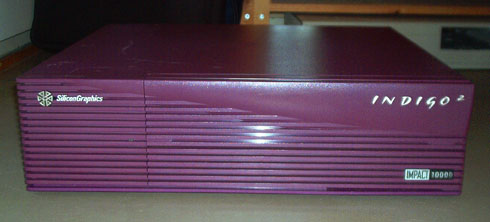Silicon Graphics Indigo2 IMPACT 10000 ("FULLHOUSE") |

| HOSTNAME | PURPLEHAZE |
| SYSTEM CPU | MIPS R10000 @195 MHz |
| CACHE (2nd, 1st D/I) |
1 MB, 32 KB / 32 KB |
| RAM | 1 GB (Max. 1 GB, officially max 768 MB) |
| SYSTEM BUS WIDTH |
64 bit |
| SCSI BUS | 2 x WD33C93B SCSI-2 (10 MB/s) |
| OPTION BUS | EISA, GIO64 |
| GRAPHICS | High Impact 24-plane 1408x1024 @76Hz |
| HARD DISK DRIVE | 9 GB Ultra2 SCSI 10K RPM |
| DVD-ROM DRIVE | Pioneer slot loading SCSI DVD-ROM |
| NETWORK | 10/100 Mbps EISA 3Com 3c597 (Phobos E100 "clone") and onboard 10baseT or AUI |
| AUDIO |
IRIS audio chip, both analog
and digital I/O |
| OS | IRIX 6.5.22 |
| YEAR | 1996 |
| SPEED | 262 VAX MIPS |
| POWER CONSUMPTION (MAX. / MEASURED) | - W / 212 W |
| COMMENTS | IRIX on this machine is fast to use, even
the version mentioned above. The IRIX GUI is very pleasant and the
over-all
feeling is very positive. If you don't like CDE, this is the hardware
&
*NIX OS you should get! |
| ESTIMATED PRICE '96 | $40,000 |
FPU: MIPS R10010 Floating Point Chip Revision: 0.0 CPU: MIPS R10000 Processor Chip Revision: 2.5 1 195 MHZ IP28 Processor Main memory size: 1024 Mbytes Secondary unified instruction/data cache size: 1 Mbyte Instruction cache size: 32 Kbytes Data cache size: 32 Kbytes Integral SCSI controller 0: Version WD33C93B, revision D Disk drive: unit 1 on SCSI controller 0 CDROM: unit 3 on SCSI controller 0 Integral SCSI controller 1: Version WD33C93B, revision D Disk drive: unit 5 on SCSI controller 1 On-board serial ports: 2 On-board bi-directional parallel port Graphics board: Solid Impact Integral Ethernet: ec0, version 1 Iris Audio Processor: version A2 revision 1.1.0 EISA bus: adapter 0 |
Back to My Hardware Collection.
| Last updated: | 21-3-2007 |